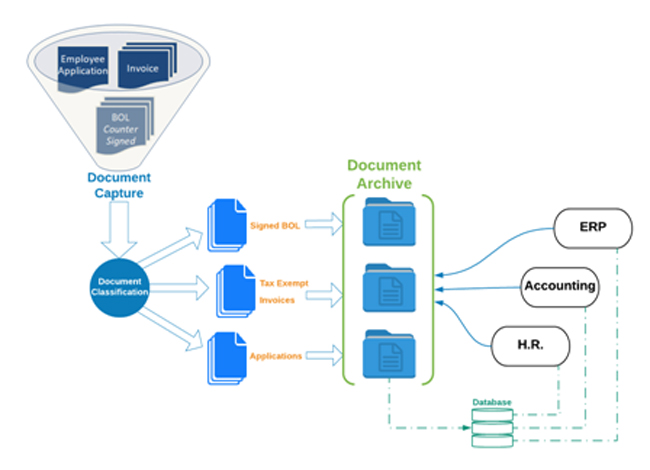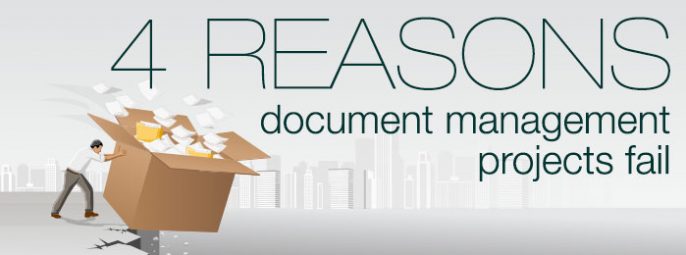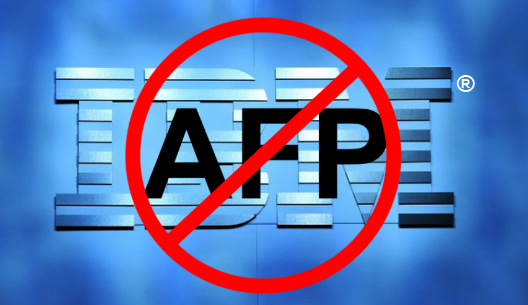Posts Tagged ‘document automation’
So…what is a workflow software?

Workflow is a generic term for a process or for the movement of information or material from one activity to another. So, what does that actually mean? Consider the inbox and outbox on your desk. These are true signs of a paper-based, inefficient business process. Imagine an office where the flow of work is all digital, and at any moment you can see the status of a work item, and who has it for tasking. Workflow has the ability to take any business process (including emails), and create a digital copy. Want to have an approvals inbox for all your invoices? No problem. Need to have contracts flow through your organization for a review process? With workflow, it’s a snap.
Simply put, workflow software provides organizations with unique technology that allows the creation of new working environments that will vastly improve the speed and efficiency of their operations. Typically, a workflow software will be used to define and manage a company’s processes and uses integrations with common day-to-day applications to execute them accordingly. Changing or altering a process becomes a simple point and click operation..
Many companies that have used workflow software successfully also claim that it has assisted them in improving productivity, increasing visibility and evenly distributes accountability. The workflow software solutions were first introduced to the tech world way back in the 1990’s and have since been gaining in popularity each year.
Since then, workflow software is required to comply with Business Process Management (BPM)’s integrated collection of critical software technologies. BPM refers to aligning processes with an organization’s strategic goals, designing and implementing process architectures, establishing process measurement systems that align with organizational goals, and educating and organizing managers so that they will manage processes effectively. BPM can also refer to various automation efforts, including workflow systems, XML Business Process languages and packaged ERP systems. The versatility of these software solutions is preferred as it enables companies to collaboratively work on designs, development or the execution of certain cycles.
Workflow automation software has vastly improved and evolved over the past couple of decades as more software companies are realizing the benefits of developing workflow technologies. It’s important to keep in mind that the majority of the most reputable workflow software solutions allow you to take the software for a “test drive” before making a costly commitment.
Especially now, with businesses offices closed and everyone working from home, workflow solutions become more and more critical to survival. So, go ahead and find the workflow software solution that best fits the technology needs of your business! Looking for an advanced Business Process Management and Workflow tool? Inform Decisions offers iWorkflow, a native IBM i workflow system as well as K2 Workflow, Forms, Data and Reports, Business Process Apps outside the IBM world.
Call our experts today. (800) 858-5544 / (949) 709-5838 or visit us at
informdecisions.com for more information about our paperless solutions and document automation.
Distribution solutions for the IBMi
inFORM Decisions is dedicated to creating innovative solutions to help clients get more from their IBM i systems.

Eliminate costly pre-printed forms and checks with laser printing on plain sheet paper with duplex printing supported. Reduce distribution costs with automated delivery by email, fax, and/or print or for indexing and storage in a Web-based archive for easy browser-based retrieval, 24×7. Include scalable bar codes, graphics, signatures and colored text. Positive Pay is an electronic process by which companies and banks can mutually increase their level of security to an organization’s check printing process.
Define complex rules for bursting and processing spool files by individual page. Intelligently sorts, re-bundles and delivers spool content to individual targets for custom distribution. Along the way, spool file attributes may be overridden, and individual pages of the report or business form may be burst, sorted, grouped, bundled and ultimately directed to a target, which can again be redirected.
Convert and distribute spooled files in popular formats such as PDF, Excel, HTML, ZIP, RTF and more. Streamline workflow with automated distribution by email or posting to file servers.
Extract data directly from your IBM database files and output directly into Excel and PDF files. Create custom queries for one or more files.
inFORM Decisions has been a Document Automation provider specializing in state of the art Document Automation solutions for the IBM i – iSeries – AS/400 arena since 1994. We believe that the IBM i/Power Systems will be relevant for a long time offering the stability and security that you’ve come to expect from IBM. inFORM Decisions is committed to the IBMi platform forever!
Call (800) 858-5544 / (949) 709-5838 or visit us at www.informdecisions.com for more information about our acclaimed iDocs suite of IBM i products.
Making Document Imports Work for You
Making Document Imports Work for You…
|
Leveraging the most out of your resources is a fundamental practice for successful managers and organizations. However when it comes to managing the flow of documents the actual practice can become distorted, failing to take advantage of many unexposed benefits. Reasons for not maximizing and making the most out of document flow ranges from lack of initial training; short comings in initial planning; unfamiliarity with installed products and system usage; being unwilling to implement changes to improve processes; and ignoring or misunderstanding the real needs of end users. Presented here is a snapshot of a few ways to consider in making your document flow manageable, beneficial to end users, and cost effective to your organization. |
 |
To figure out where to start look at the end point…
Typically either with the end users or established procedures is where managers can begin to address document management practices. This is a great opportunity and starting point to drill down on actual needs for an organization. The discovery phase could be considered one of the most important parts of the process if not the most important part of the process. However it’s surprising how many managers don’t make the time to dig deeper into the actual needs of their end users. This typically leads to configuring a document solution that only partially meets the needs of the end users.
In the scenario that we’ll be using, as shown on the above diagram, we will be working with three different departments.
|
Although we have three very different needs for each of the departments, they do have some commonality which we’ll use to leverage our solution and make managing the document process easier.
|
Reduce, Reuse, Repeat…
We are going to use two components to provide each of the departments there own unique setup.
The objective is to replace manual repetitive work done by people with machine driven processes. This will reduce the number of times that a worker will touch a document or have to key in data or have to shuffle paper around the office. From a technical managing point of view, we want to reduce and reuse the number of component being used to make it easier to manage the overall document management ecosystem. Once setup, we want the automation of repeated steps to process forward with as few human touch points as possible.
First consider a document management system like iView from inFORM Decisions. This will handle each of the applications separately. We’ll be able to store each of the document images in their own unique directory and write the captured metadata into separate tables. We’ll use the metadata as index fields to look up the documents at a later time and to push/pull data into the different operational systems for the company like the company’s ERP system and Accounting system. Additionally, we’ll use the front end portal; iView Document Center, to manage access to specific document types. This will make it easy to assign users from each of the departments to their own specific documents keeping the segregation of documents and data separate between departments.
Second is document capture system like iCapture that will monitor an entry point for your documents and automate the document capture process to your needs. In our case scenario we want to make it as easy as possible to manage the incoming documents for the technical manager administrating the complete document system and more importantly for the end users at each of the three departments.
In our setup, we are going to have different table top scanners like the Fujitsu Fi series scanners in each of the departments. As each of the departments scan in their originating documents in the different geographical locations, the documents will get funneled into a central collection point. The collection point can be either a single folder or a group of separate folders for each of the documents. The capture software will automatically monitor the collection point for new documents to begin the capture process.
Within the capture process we can apply Classification rules to identify each of the different types of documents. The classification step provides an important point in which we automate the separation of documents by identifying the documents at the entry point. This allows us to apply different handling rules for each of the different document types although all the documents arrive in a central collection spot. As each of the documents proceeds in the capture process, they each will follow their own unique configurations for indexing the metadata from the OCR process, validating the collected data, processing via Quality Assurance steps, and Migration steps. In our scenario, we are delivering the images of the captured documents into the iView Document Center and we are delivering the captured metadata into a database’s separate tables for each of the department’s unique systems.
Simple to complex…
By now you must be saying to yourself… This is a simplistic view to a bigger solution… and you are right.
My objective in this short article is to convey a few principles able to make your document import experience a successful journey.
Take the time to really understand your document management needs.
As managers of technology, operations, departments, and employee experiences it’s easy to become reactive as the pressures of demand push to get quick results. We’ve seen it over and over… those who engage deeper into the discovery of end user experiences and dive deeper into the overall needs of the organization tend to maximize their return in solution investments.
Manage your software tools.
From a technical managing point of view, keep your solution components to a few solutions that really provide you with what you really need and learn to use them. Learn to use your tools to take advantage of as many functions as they provide instead of adding another tool. Many times we run into folks that don’t realize that they have had the functionality in a current software tool they already own. If not sure, reach out to your contact for answers. This applies to putting together a document management system. Use tools that you can really use like iView from inFORM Decisions.
Keep the continuity of steps understandable.
When possible, use the same or similar steps in carrying your documents from the starting point to the end point. Have a central collection point to send documents into from all different locations in your organization; identify the documents using Classification configurations; process the documents with indexing and migration rules that are specific to a document type; and delivery useful data that is searchable to your end users. Keeping the flow of steps linear will make it easier for managing and troubleshooting your document management process.
Times are always a changing.
Always know that the best laid out plan will at some point change. In our modern world technology environments, regulations, and procedural shifts will at some point require your document management configurations to be altered. By having a sound laid out understanding of your document processing and of your tools like iCapture and iView, you will be able to better handle changes without having to reinvent your core document capture ecosystem.
Go beyond this article…
Contact us at inFORM Decisions to learn more about how we handle document management.
inFORM Decisions, Inc.
www.informdecisions.com
Call: (949) 709-5838 | Send email: info@informdecisions.com
Reasons Document Management Projects Fail

These days, many organizations are seeking operation efficiencies, trying to improve productivity and stay ahead of their competition. The key to optimizing business processes is built around a digital document management system. Finding a suitable document management solution is not merely a matter of researching options and purchasing a system. Finding one that doesn’t work as well as well as t was supposed to and then moving on to the next it why most projects fail.
Here are 4 reasons document management projects fail and how you can ensure yours succeeds:
1. The system doesn’t fully deliver. Maybe you were diligent in finding the best document management solution available. You got it all set up but aren’t seeing a return on your investment. . Often DMS digital tools don’t fully deliver because they don’t address the underlying questions of how the business stores and utilizes their information, or are not user-friendly.
2. Users haven’t bought into the solution. It’s unrealistic to expect your staff to embrace a system that is not intuitive and requires a ton of manual work. The point of your document management system is to avoid time-consuming processes and inefficiencies. If document management is unpopular in your workplace, it’s time to take a hard look at your system. If your users—the ones who are responsible for the day-to-day interactions with the system—haven’t bought into it, carve out some time to educate them on the system. Moreover, explain how using it properly will make life easier for them. Remember, bad habits are difficult to overcome.
3. Your goals were not specific enough. Goals like a paperless office, or to lower your document processing expenses are great big-picture goals, but they’re not specific and measurable. Failing to have specific goals can ultimately lead to failure. Instead of generalized goals, set some benchmarks that you can track, Start small and set a goal date for fully implementing the solution in a specific department. Take the time to measure your results, so you know just how effective the solution is. If your staff sees impressive results, then move on to the next department.
4. Failure to plan. Failing to plan is planning to fail. First fully understand how your organization stores and utilizes information. It’s best to plan out your project in phase’s .Start in a department that is most in need of the solution—often this is Accounts Payable or Human Resources. These departments are likely to see a quick return on investment. Thus, the staff will be helpful in getting other departments excited for the solution. Here’s a quick example of a basic implementation plan:
• Implement the system in a single department of your organization.
• Monitor feedback from the staff and any concerns they may have.
• Make any necessary changes to the process to ensure maximum user adoption and satisfaction.
• Once that department is implemented and is proficient in using DMS, have them assist in educating the next department. Outline your goals and make periodic assessments to determine if the solution is working and whether you need to make any changes.
Contact inFORM Decisions to learn more about user-friendly document management that offers a serious return on your investment.
IBM ends AFP support
IBM Drops Support for Advanced Function Printing Utilities

Last year it was announced that the 5770-AF1 IBM Advanced Function Printing Utilities will not be supported on IBM i V7R3 OS. While there is no indication that the AFP data stream and protocol are no longer supported, the AFP Utilities and the InfoPrint tool for designing pages will not be supported in V7R3. This would indicate that you can continue to print existing applications, but that you can not create a new form overlay or modify an existing one.
A replacement for APF to consider is the acclaimed iDocs Forms Suite from inFORM Decisions. iDocsTM provides easy-to-use forms designer and spool file data mapper with menus to set up business rules for manual or automatic processing and intelligent distribution of merged, formatted reports, forms and security MICR checks. Print in color with graphics and bar codes.
The snap-on Laser form printing module attaches to the iDocsTM Administrator to provide menus and business rules for defining dynamic, complex document printing operations on the IBM i. This solution is usable with all iSeries, System i and Power Server accounting/ERP solutions including JD Edwards, Mapics, Lawson, HTE, SAP, ORACLE, Computer Guidance, Optimum, Metalware, Pansophic, DCMS, PRMS, Infinium …any software application that generates a spool or XML file output.
With iDocs, you can replace AFP while modernizing your documents and improving your workflow processes; distributing documents as PDF via email and fax, optionally archiving and importing them into a paperless Electronic Content Management system.
inFORM Decisions has been a Document Automation provider specializing in state of the art Document Automation solutions for the IBM i – iSeries – AS/400 arena since 1994, we believe it is clear that the IBM i systems will be relevant for a long time offering the stability and security that you’ve come to expect from IBM i. inFORM Decisions is committed to the IBM i iSeries AS/400 platform forever!
inFORM Decisions has been an IBM i (iSeries, AS/400) native, Document Management and Workflow software development company since 1994. Our business partners and customers are worldwide and lend testimony to the state of the art, stability of IFD solutions.
Call (800) 858-5544 / (949) 709-5838 or visit us at www.informdecisions.com for more information about our acclaimed iDocs suite of IBM i products.

The 3 Amigos of Process Automation: Capture, Workflow and Archive
Document Automation: Before, During and After
As organizations try to become paperless, there are 3 key stages in digital transformation, and eliminating as much paper as possible. To truly achieve automation from end-to-end, all three stages need to be implemented. Here are some details:
- Capture – the capture stage can mean different things for different processes. If you have a stack of paper invoices, and are looking to automated you AP process, obviously a scanner with document capture software would be key. But take a broader look, and capture can apply to other areas. Maybe you have an AS400 that prints POs? Implementing a spool to pdf solution would create digital files rather than paper. Another area might be inbound fax, or perhaps email with attachments. The overall goal of capture is to set a virtual perimeter around your organization that captures inbound documents and data, and passes them to a line of business system or a workflow process.
- Workflow – a business process management suite or workflow tool can provide a means to move documents and data throughout your organization. It can be fed information from any capture process, and provides the ability to avoid “efficiency killers” like the email inbox or file share. Take for example a hospital that has referrals faxed to a number, they are captured and passed to a queue for processing by staff. This digital process provides maximum efficiency, prevents lost or overlooked items, and with reporting tools, management can have great insight into the process.
- Archive – So what happens when it’s all over? In today’s environment, documents and data need to be readily available for review, audit purposes and legal needs. Both workflow and capture can provide an integration to repositories for storage of document and information. Take the fax process outlined above. The final step could be an archive of the inbound fax and metadata into a specific SharePoint library, or perhaps an OnBase document repository. The archive provides easy search for processed information, and create a digital file cabinet for your organization.
As you evaluate your internal processes, and look to automate, make sure you approach all 3 stages of the document automation chain.
inForm Decisions Home Page
|
Let us answer your questions…
|
|
||
|
Schedule a call… |
|||
-
Generate forms, reports, and checks natively on the IBMi
Upload document designs and mapping instructions to our iDocs software on the IBMi and immediately utilize our iDocs Engine or use our API commands to start generating your forms, reports, and checks.
-
Distribute generated documents, reports, and files natively from the IBMi
Automatically deliver documents and reports in a variety of different formats including .PDF, .XML, .TXT, .TIF, and .XLS via email, fax, FTP, SFTP, FTPS, as wells as into local and remote directory. Additionally delivery Positive Pay reports to banks, and more.
-
Capture documents and data to convert into useful electronic versions
Import files from scanned documents, email attachments/email body, shared folders, or directly from originating systems. Identify different incoming documents, extract useful data from imported documents, run database look ups, validate collected data, and export to a repository and accounting/ERP systems.
-
Automate and manage the flow and circulation of documents, forms, and files.
Controlling how the flow and circulation of documents moves in, out, and around of an organization is a critically important to the efficiency of an organization. Automatically route files based on triggers and conditions to help improve the speed of the flow of information.
-
iCapture provides all the required features for any scanning or document capture project. OCR, copier integration, and automated extraction can help you convert your paper to digital format.
-
The K2 no-code Business Applications Platform provides workflow, forms, reports and data integration capabilities to any organiztion. It is an essential piece to any digital transformation strategy. With K2 blackpearl you can provide workflow in SharePoint, mobile forms and powerfulw reporting dashboards in a snap.
-
iDocs monitors Output Queues for spool files , database files or XML data to process and route based on user-defined business rules on the IBM iSeries.
-
iWorkflow is a powerful workflow engine for enabling the iSeries and AS400 for business process management.
Build Your Own Apps – Webinar Recording
BYOA: Build Your Own Apps for the IBM AS400 and DB2 – Webinar Recording -K2 Webinar by Stephen Boals of K2.
With K2, companies have all the necessary tools to build no-code, powerful business apps that leverage IBM i and all of the other business systems throughout your organization.
In this webinar, view a demonstration of how K2’s four-pillared approach integrates different business systems opening up access to data that is currently difficult to access. Learn about the new trend in Build Your Own apps and how it will help you improve efficiency and productivity.
Contact us for more information on all these applications at 800-858-5544.
- 1
- 2















